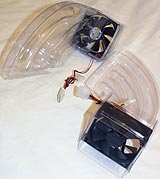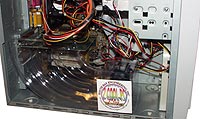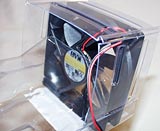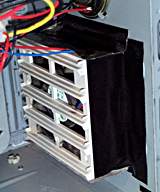
2COOLPC ducted fans for computer cooling
Review date: 6 July 2000.Last modified 03-Dec-2011.
Glamorous it ain't, but computer case ventilation is important. Modern personal computers are full of componentry that pumps out lots of watts of heat.
Current Pentium IIIs running at stock speed have less than 20 watts of heat output, but older ones run hotter, and even the current lower-power "Thunderbird" AMD Athlons are considerably toastier again.
Add the heat from video card and motherboard chipsets, and the heat from hard drives as well - friction between the rapidly rotating platters and the air inside the drive keeps even slow drives quite warm - and you end up with a serious heat source to deal with.
Since all but the most, ah, peculiar PCs use simple through-flow air cooling to carry all of that heat away, airflow matters.
It doesn't matter how gigantic your processor heat sink is, or how many fans it has blasting air across it, if that air is just going round and round inside the case. If fresh air isn't being drawn into the case and hot air exhausted, you will in time end up with a PC that is, literally, too hot to touch. Which is bad.
Moving air
Every normal PC has at least one fan in it - there's one built into the Power Supply Unit (PSU). The ATX form factor specification that most modern PCs use originally said that the PSU fan should blow into the case, so air would go straight onto the CPU, which is next to the PSU internal vent grille.
Practically all manufacturers ignore this specification, though, because blowing air that's just been drawn through a warm power supply onto the CPU didn't turn out to work any better than the old exhaust fan design, where the PSU fan points the other way and sucks air through vents on the front, side and back of the computer and blows it out of the rear PSU grille.
A PSU fan by itself, though, is pretty weedy. Many computer cases have a second fan location; in tower cases it's always at the bottom front. Mount an inward-blowing fan there and you ought to greatly increase the case ventilation.
But you might not increase it enough, and you might not increase it usefully.
Airflow through many cases is impeded by tons of cables. Even if all you've got is a hard drive and a CD-ROM running from the one IDE ribbon cable, that plus the floppy drive ribbon cable and the various used and unused power supply cables can significantly slow air flow.
Add more cables - extra IDE and SCSI devices - and the inside of the computer can rapidly start resembling an eight-dimensional macramé flowerpot holder.
And, even if you route and bundle your cables carefully, airflow oddities may mean that a lot of the air passes over nothing that needs it.
Generally speaking, electronic equipment works less well the warmer it gets. More heat means more resistance. Electrons have a harder and harder time moving through a conductor the warmer it gets.
In the case of PCs, though, it's not a simple proportional situation, and different components care about heat to different amounts.
A computer that's 10% hotter isn't going to crash 10% more often, and its components, in general, aren't going to die 10% earlier. Computer components are meant to tolerate high ambient temperatures; the manufacturers know that most of them are going into toasty little under-ventilated cases.
Hard drive motors and bearings are made to tolerate considerable thermal expansion. CPUs have core shutdown temperatures hotter than most people's hot water. Even things like CD writers, which originally needed to be mounted in separately cooled external cases for reliable operation, now put up with sharing the silicon sauna with everything else.
Given that high-ish temperatures aren't that big a deal, you can get away with not much case air flow at all, as long as the air's directed at the things that actually need it. Most drives get all the cooling they need from the metal-to-metal contact they have with their mounting rails - only the super-fast 10,000RPM and higher models need special cooling. And most expansion cards don't care too much, either.
Your CPU and your video card are likely to be the first components to go flaky when the mercury gets too high. Modern 3D accelerated graphics cards run hot, and have to have small chip coolers on them so they don't obstruct adjacent card slots. And CPUs, as mentioned above, can run pretty warm too; their stock coolers are also, often, not good for much.
Some people put enormous and/or multiplicitous cooling systems in their PCs for the same reason that people of similar outlook put giant wings and ludicrous air dams on their cars, but you don't have to go that far. Just corralling the cables a bit and putting a second fan in the front mounting location will do to get passable ventilation for most PCs.
It's hardly an efficient way to do it, though. If you just encourage general air flow, then quite a lot of the air that passes through your PC won't have passed over any of the components that actually need to be cooler.
The solution
Which is where 2COOLPC comes in. They make ducted fans for PCs.
Of course, everyone knows what a ducted fan is. It's what you use when you want a model plane to look as if it's got a jet engine, without putting a real one in it. And they're used in other, ah, small aircraft, too.
Apparently, though, there can be other kinds of ducted fan, and the different flavours of 2COOLPC unit are among them.
The idea's simple enough. There's not much to it - just a lightweight sculpted plastic duct with a fan in the end of it. It mounts in pretty much any tower-shaped PC case, with the fan pointing at the front air vent (which may or may not have its own fan installed) and the duct pointing down over the motherboard, to deliver air to the video card and CPU.
The fan's a 92mm square unit. Some computers use 92mm case fans, but most have the smaller standard 80mm units. All things being equal - just scaling all of the dimensions up and assuming the same rotational speed - a 92mm fan can be expected to shift about 30% more air than an 80mm one. All things aren't necessarily equal, though; if the bigger fan has the same motor then it'll spin slower, and have a smaller airflow advantage. Bigger's still better, though.
The fans are standard 12 volt units, and you plug them into your power supply with an ordinary four pin Molex plug-to-socket passthrough cable. So you don't need to have a spare connector.
The plain $US24.95 2COOLPC has a sleeve-bearing fan rated at 42 cubic feet per minute (CFM) air flow; the PLUS version has a ball bearing one rated at 50 CFM. These ratings are free-air figures, not taking into account the obstruction value of the duct, but unlike airflow figures for regular case fans or CPU coolers, the 2COOLPC fans don't have a lot of obstructions to blow air through and so probably perform pretty close to their specification.
The higher capacity fan's better bearings mean it's likely to last longer, but even cheap sleeve-bearing fans can reasonably be expected to last years in continuous service. 2COOLPC quote the thick end of three years as the expected life for their sleeve bearing fan. Ball bearing fan lives are considerably longer, though; 2COOLPC say the one they use should last more than seven years.
Mounting the cooler isn't exactly rocket science. If your computer doesn't get moved around, then all you need do is put the 2COOLPC in the box so that the blower end of the duct is hard up against the back panel. The wide end of the duct blows air down over the video card, if you're using an AGP card or the topmost PCI slot for your graphics board.
Just sitting the duct in the case, though, means it'll rattle around inside if you move the computer.
The fan's not going to eat anything if the computer's tilted forward while it's on. There's a lip around the front of the duct that makes it quite difficult for any cables to hit the fan. Even if something does interfere with the fan, it's not going to chew through insulation in any reasonable period of time, and the fan motor won't burn out if it's jammed.
But, to keep the duct where it's meant to be, 2COOLPC include a few little self-adhesive Velcro buttons with the package. Presto - a solidly mounted duct that can easily be removed when you need access to your expansion cards. Velcro dots wouldn't do for holding anything weighty in place, but the 2COOLPC is very light, so they're more than adequate.
The input end of the duct only partially covers the fan, so some of the air swirls around over the other expansion cards.
Because the 2COOLPC fan sits fairly close to the front-bottom vent, it'll work pretty well even if you don't have a second case fan installed. If you do have a couple of case fans, and especially if you've...
...taken a moment to improve the usually-crummy seal the fan mount cage has on the front of the case, then the 2COOLPC should get an excellent supply of cool air and dump it onto the components that actually need it, instead of letting more than half of it pass them by.
Overall
It's not at all a bad idea to at least take basic steps to keep the air moving through your computer, and moving around properly inside.
A lot of PCs, after all, have bargain-basement hardware in them, which may be less than totally reliable at high temperatures. Every modern PC is a unique high performance, low cost hardware cocktail, and it's hardly surprising that a lot of them end up being rather flaky.
Now, the vast majority of system crashes can firmly be blamed on software - definitely including Microsoft's consumer operating systems - but it doesn't hurt to spend a few bucks improving the stability of the hardware, especially for mission-critical machines.
Even if it makes only a small difference to reliability, the investment of time and money can be small enough to make it thoroughly worthwhile, particularly for office environments with lots of PCs and support staff who'd rather not have quite so many hardware failures.
$US24.95 is quite a lot to pay for some folded blow-moulded plastic with a fan stuck in the end. And that's just for the plain 2COOLPC; the ball bearing PLUS version is $US34.95, and there's a version with a three pin power plug (for connecting to the fan headers on more recent motherboards) that costs $US39.95.
If you're not in the mood to make your own duct arrangement out of cardboard, though, the 2COOLPC could be a great drop-in upgrade.
Pros: |
Cons: |
|
|
2COOLPC ducted fans kindly provided by 2COOLPC.
You can order 2COOLPC products direct from the makers here.






